Custom Keycaps Benefits: Why Personalised Keyboards Enhance Your Experience
Updated On: November 13, 2025 by Aaron Connolly
Core Advantages of Custom Keycaps
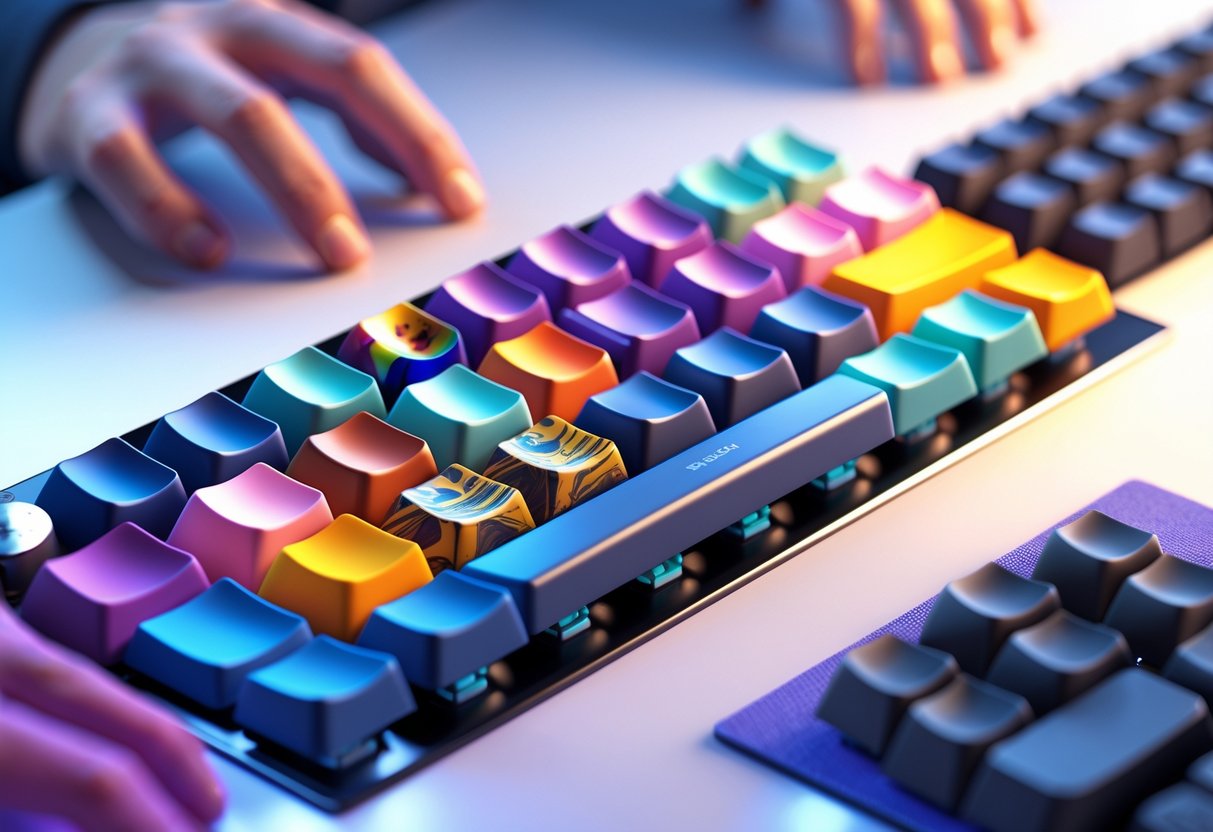
Custom keycaps can totally change your mechanical keyboard experience. They let you personalise your setup’s look, boost comfort while typing, and add durability that standard keycaps just can’t match.
Personal Expression and Style
Custom keycaps put you in charge of your keyboard’s vibe. You can pick from thousands of colours, themes, and wild designs that actually fit your desk and gaming setup.
Popular customisation options include:
- Minimalist designs – Clean, simple colours for a professional look
- Gaming themes – Keycaps with your favourite games or characters
- Artisan keycaps – Hand-crafted keys that stand out as centrepieces
- Novelty sets – Fun fonts, patterns, and quirky styles
The options are wild compared to what comes with most keyboards. No more settling for boring black or white keys.
A lot of esports players choose custom keycaps to make their setup feel truly personal. When your gear looks how you want, you feel more at home with it.
Colour psychology can play a role. Bright colours might hype you up for a marathon session, while softer tones help you focus when it matters.
Enhanced Typing Experience
Keycap materials and shapes really change how your keyboard feels. That affects your speed and comfort, especially if you’re gaming for hours.
Key material differences:
- PBT plastic – Textured, doesn’t get slippery with sweat
- ABS plastic – Smoother, but goes shiny over time
- Double-shot keycaps – Letters never fade, even after years
The profile (shape) of your keycaps also matters. Cherry profile sits lower and often feels more natural. OEM profile is taller and might suit bigger hands.
Heads up: Not every keycap fits every keyboard. Always check your switch type and layout first.
You’ll notice the difference right away. Smooth, quality keycaps let your fingers glide and cut down on fatigue. Better grip means fewer missed keys, especially when things get intense.
Keyboard Durability Improvement
High-quality custom keycaps outlast the basic ones by years. You’ll save money and your board will stay looking sharp.
Durability comparison:
| Keycap Type | Lifespan | Fade Resistance | Shine Resistance |
|---|---|---|---|
| Standard ABS | 1-2 years | Poor | Poor |
| PBT Custom | 5+ years | Excellent | Excellent |
| Double-shot | 10+ years | Perfect | Good |
Good keycaps shrug off heavy gaming. Your WASD keys won’t get that shiny, worn-out look so quickly.
The legends (letters and symbols) on top-tier keycaps are laser-etched or double-shot, so you don’t have to worry about them wearing off.
Quick tip: Start by upgrading the keys you use most. Add more as your budget allows.
Many custom sets also improve backlighting. The light shines through more evenly, making your RGB setup pop.
Boosting Typing Efficiency with Custom Keycaps
Custom keycaps can actually help you type faster and more accurately. They also cut down on hand fatigue during long gaming sessions or practice.
The right profile, material, and texture all work together to make your typing smoother and more comfortable.
Typing Speed Enhancement
Custom keycap profiles really do affect your typing speed. Cherry and OEM profiles put your fingers at better angles for quick presses. Cherry profile is lower, so your fingers don’t have to travel as far.
Materials matter too. PBT keycaps have a textured feel that helps your fingers find the right keys faster than slippery ABS. This grip can bump up your words per minute once you get used to it.
Uniform profiles like DSA are great for alternative layouts. If you use Dvorak or Colemak, even key heights help keep your fingers steady.
Thicker keycaps add a bit of weight and make each press feel more solid. That feedback can help you settle into a steady rhythm, especially during long practice sessions.
Accuracy Improvements
Clear legends make a difference. Double-shot moulded legends don’t fade, so you always know which key is which. Dye-sublimated legends offer similar durability and cost less.
Textured keycaps on certain keys boost accuracy. A lot of people add texture to F and J for home row placement, or WASD for gaming movement.
Consistent keycap height helps too. Standard keyboards sometimes have weird row heights that throw your fingers off. Uniform profiles fix this, so you miss fewer keys.
Colour contrast matters. High-contrast combos, like white on black or vice versa, make keys easier to spot in low light.
Reduced Typing Fatigue
Ergonomic keycap profiles really help with finger strain. SA profile keycaps, for example, have a curved shape that follows your fingers’ natural movement. It takes less effort to hit each key.
Material choice affects comfort too. PBT keycaps stay cooler and don’t go shiny and slippery like ABS. Your grip stays steady, even after hours of use.
Thicker keycaps soften the blow. Even a small bump in thickness can make long sessions more comfortable.
Sound plays a part as well. PBT keycaps sound deeper and less harsh than thin ABS, which can make those long typing or gaming marathons a little less tiring.
Material Differences and Their Impact
The plastic you pick for your keycaps changes your daily typing more than you might expect. ABS and PBT are the big names, but POM and some others bring unique feels for people who want something different.
ABS Versus PBT Keycaps
ABS keycaps start out smooth and silky. They create a higher-pitched, clicky sound that some people really like. Premium ABS brands like GMK give you awesome colour and deep blacks that look fantastic.
But ABS gets shiny. After a few months, finger oils wear down the texture, and you get glossy spots where you type most. It doesn’t break anything, but it’s not everyone’s favourite look.
PBT keycaps are pretty much the opposite. They feel a bit rough and matte, so they’re less slippery. The sound is deeper and more muted—what keyboard folks call “thocky.”
PBT wins on durability. These keycaps shrug off finger oils and don’t get shiny, even after years. Modern dye-sublimation gives you bright colours and sharp legends that stick around.
POM and Other Unique Materials
POM (Polyoxymethylene) keycaps feel super smooth, almost waxy. They sound deep and soft, and they don’t get shiny either. If you’re after a quiet board, POM is a solid pick.
Polycarbonate keycaps are clear or smoky, which makes them perfect for showing off RGB lighting. Metal and resin artisan keycaps bring wild looks, but people usually just use them for accent keys.
These materials let you go way beyond the basics, but they usually cost more than ABS or PBT.
Ergonomics and Comfort
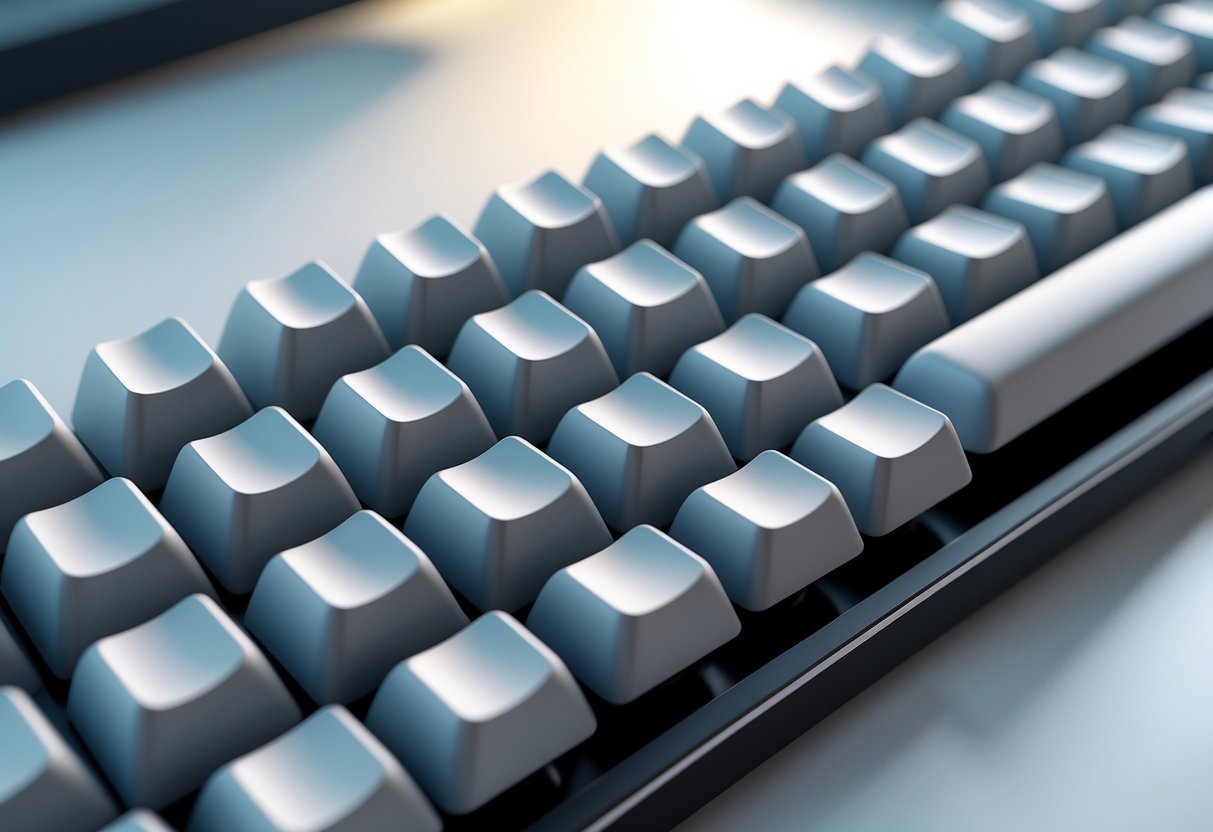
The right profile and shape on your keycaps can make typing way more comfortable. Good customisation cuts down on wrist strain and finger fatigue and helps you stay accurate, whether you’re gaming or working.
Profile Selection for Comfort
Keycap profiles set the height and curve of each key. Different profiles work better for different hands and typing styles.
Cherry Profile is the shortest at 9.5mm. Less travel means faster key presses—great for gaming.
OEM Profile sits at 10.9mm and balances height and comfort. If you angle your keyboard at around 6°, it feels pretty natural.
SA Profile is tall at 14mm, with deep curves. Writers love the feedback, but it takes time to get used to the steep angle.
XDA Profile is flat and uniform at 7.6mm. It’s great for custom layouts like Dvorak, and people with smaller hands often prefer it.
Keycap Shapes and Ergonomic Benefits
Sculpted keycaps follow the way your fingers naturally move. Unlike laptop keys, they curve and dip to match your hands.
Spherical dishes on top of the keys help centre your fingertips. That means fewer mistakes and better grip.
Row-specific heights create a gentle slope across the keyboard. Your fingers naturally curve down as you move from top to bottom, and good profiles support that.
Textured PBT surfaces keep your fingers from slipping, even during intense games. The texture isn’t rough, but it gives you just enough grip.
Pick the wrong keycaps, and you might end up with wrist pain or awkward hand angles. The right profile cuts down on stretching and keeps your hands comfy, even after hours of use.
Aesthetic Customisation Options
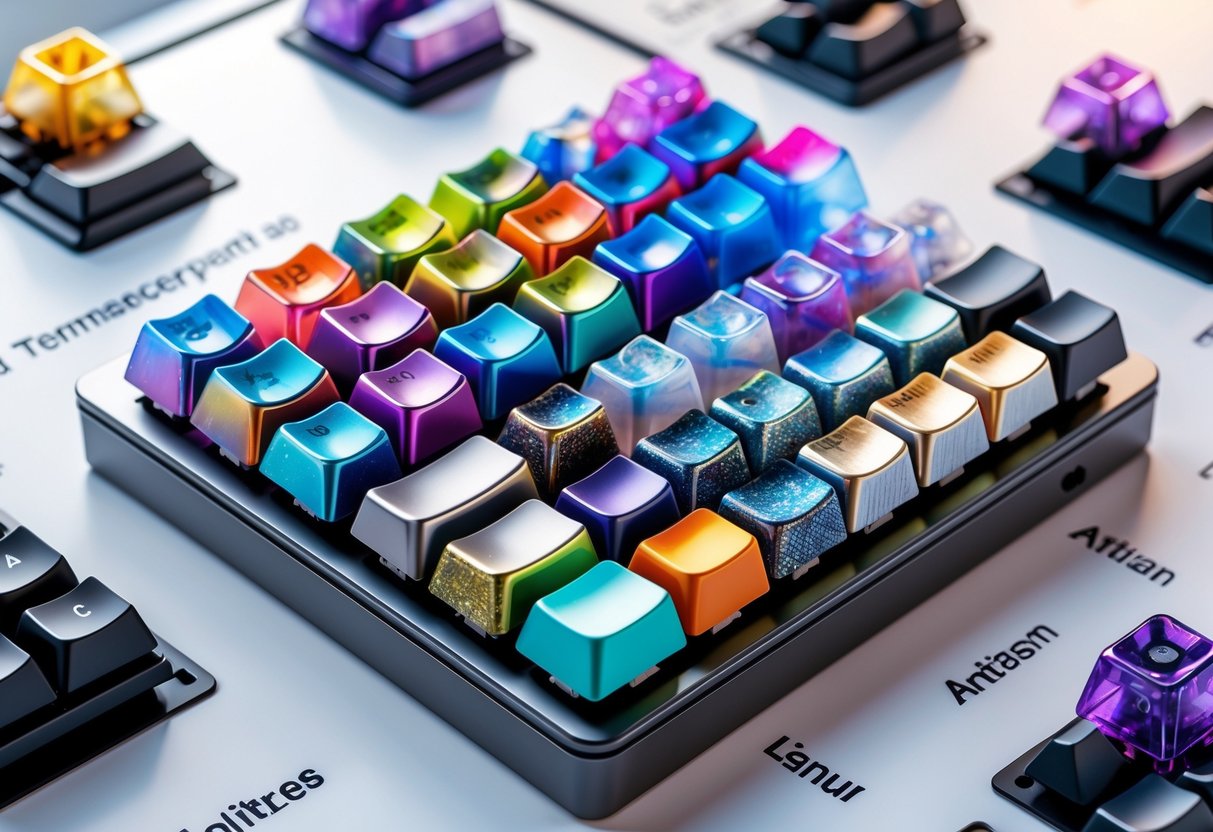
Custom keycaps let you turn your keyboard into a real statement piece. You get to choose colours and designs that match your setup or just your mood.
Colour Choices and Themes
You can pick almost any colours you want for your custom keycaps. Go for vibrant RGB schemes to match your PC lights, or stick with subtle monochrome for a sleek look.
Popular themes include:
- Gaming styles: Neon greens, blues, and reds
- Pastels: Soft pinks, mint, cream
- Professional: Greys, deep blues, crisp whites
- Retro: Beige and browns, old-school vibes
A lot of brands make themed sets based on games or franchises. These usually blend colours and designs across the board.
Customisation isn’t just about single colours. Gradient sets fade from one shade to another. Two-tone combos split the keyboard into bold sections.
Keycap Art and Graphics
Modern keycaps can be tiny works of art. Artisan keycaps are hand-made, with everything from little sculptures to painted scenes.
Common graphic options:
- Gaming icons: Weapons, characters, logos
- Abstracts: Geometric patterns, marble, wood grain
- Custom legends: Your own text, symbols, or languages
- Transparents: Let your RGB lighting shine through
Resin keycaps can have flowers, glitter, or tiny figures inside. Double-shot keycaps use two plastics, so the legends never fade.
It’s usually smart to start with a few accent keys. That way, you add some personality without overdoing it or blowing your budget.
Sound and Feel Customisation
Custom keycaps totally change how your keyboard sounds and feels. The materials and designs you pick shape the whole typing experience.
Different keycap materials give you unique tactile feedback. ABS keycaps feel smooth and light under your fingers, which makes fast typing or gaming easier.
PBT keycaps, on the other hand, come with a slightly rougher texture. Many people love how solid they feel—they don’t get slick, even after hours of use.
Keycap thickness matters too. Thicker keycaps, like those from GMK, feel more premium. You get a satisfying firmness when you press down, with less flex.
Keycap profile plays a big role in comfort. Cherry profile sits low, while SA profile stands tall and sculpted. Your fingers will notice the difference as they glide across the keys.
Sound Damping with Different Keycaps
Custom keycaps really change your keyboard’s sound signature. Material choice has the biggest impact on what you and everyone around you hears.
PBT keycaps usually sound deeper and quieter than ABS. If you work in an office or share your space, these can keep the noise down.
ABS keycaps ring out with a higher-pitched, sharper sound. Some gamers actually like this because it gives that satisfying feedback during intense moments.
Keycap thickness helps dampen sound, too. Thicker caps soak up more vibration, so you hear less of that hollow ping that thin, cheap caps often have.
Double-shot keycaps sound fuller thanks to their two-layer build. More mass under your fingers changes the way each keystroke resonates.
Unique Keycap Types
Custom keycaps come in a bunch of different manufacturing styles. The style you pick affects both how they look and how long they last.
The two main categories? Precision-made keycaps like double-shot or dye-sublimated, and then the wild world of artisan, handmade pieces.
Double-Shot and Dye-Sublimated Keycaps
Double-shot keycaps use a two-part moulding process, so the legends will never fade. The letters and symbols come from a separate piece of plastic, not just paint.
This method keeps legends crisp, even after years of heavy typing. Manufacturers inject two different colours of plastic to make a single keycap.
Dye-sublimation keycaps get their designs through heat-bonding ink directly into the plastic. Some brands even use five-sided dye-sublimation for extra detail and colour.
These keycaps work best with PBT plastic, which outlasts standard ABS. The dye-sublimation process means the designs won’t chip or peel.
Both types offer excellent visibility for gaming and typing. Gamers especially love them for their durability and looks.
Artisan and Handmade Keycaps
Artisan keycaps take customisation to the next level. Artists hand-paint or sculpt these, so every piece is unique.
People often commission artisan keycaps to match a specific theme or colour scheme. Some artists do limited runs, so certain designs become rare and highly prized.
Hand-painted keycaps can show off incredible detail—mini landscapes, character portraits, or wild abstract art. Mass-produced caps just can’t compete.
The artisan community is a mix of veteran makers and new talent. Collectors chase after favourite artists or even collaborate for custom pieces.
Artisan keycaps cost a lot more than regular sets, but they’re both functional and collectible. For some, it’s less about typing and more about owning a tiny piece of art.
Optimising for RGB Lighting and Visual Effects
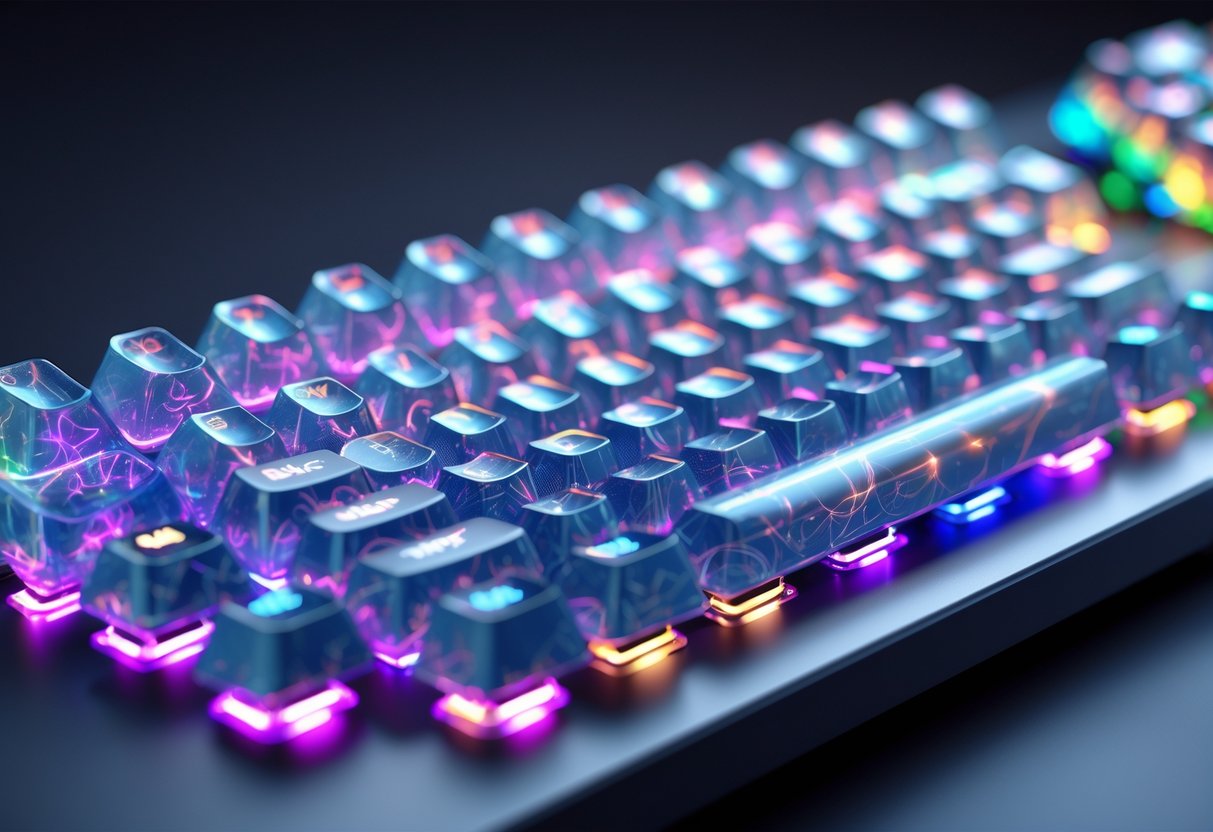
Some keycap materials let more light shine through, which can make your RGB effects look incredible. The right keycap choice will make your keyboard’s lighting pop—or keep it low-key, if that’s your thing.
Pudding and Translucent Keycaps
Pudding keycaps have translucent sides and opaque tops. This lets RGB lighting spill out the edges, but the legends stay clear and readable.
The light glows softly outward, not in-your-face like with fully transparent keycaps. It’s a nice balance.
Translucent keycaps go all out for brightness. These clear or semi-clear caps let light pass through almost entirely, so every colour comes through bold and bright.
Popular translucent materials include:
- Clear polycarbonate
- Frosted acrylic
- Semi-transparent PBT
For a custom look, you can mix and match transparency levels. Maybe clear caps for your gaming cluster, pudding for the rest.
Highlighting RGB and Backlit Features
Standard ABS and PBT keycaps mute most lighting. Thick plastic blocks a lot of the glow, which works if you want backlighting that’s subtle.
RGB-friendly keycaps boost lighting features like:
- Shine-through legends – Letters and symbols light up clearly
- Side lighting – Fills the gaps between keys
- Under-glow effects – Spreads ambient light around your keyboard
Before you buy, check your keyboard’s LED setup. Top-mounted LEDs work best with shine-through caps, while side-mounted LEDs pair nicely with pudding styles.
Some gaming keyboards let you swap out the LEDs entirely. Brighter lights plus the right translucent keycaps can produce seriously cool effects—sometimes even synced with your games or playlist.
Custom Layouts and Functional Benefits
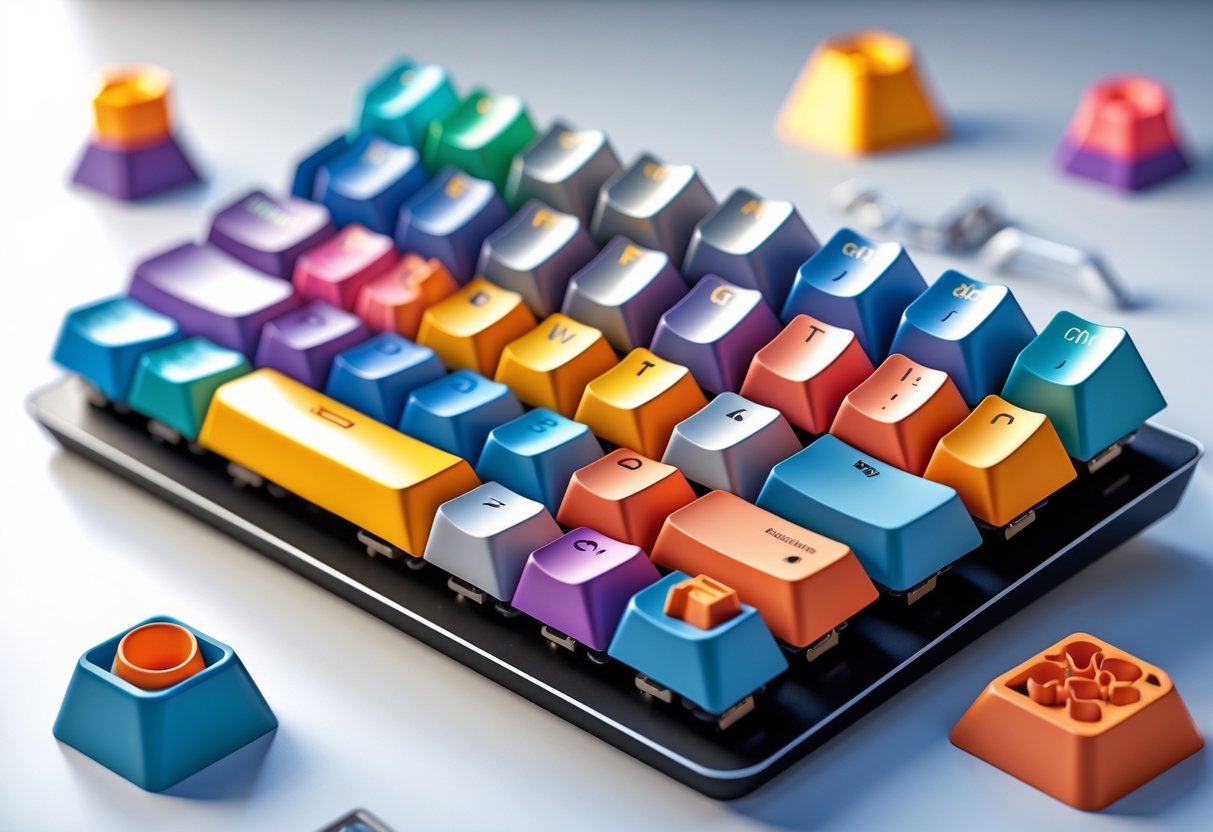
Custom keycaps aren’t just about looks—they unlock practical features too. Programmable layouts and clear labelling help you type faster and make fewer mistakes.
Programmable and Special Layouts
Custom keycaps work great with programmable keyboards. You can move keys around to put your most-used characters right where you want them.
Popular custom layouts:
- Dvorak – Common letters land under your strongest fingers
- Colemak – Keeps some QWERTY familiarity but boosts efficiency
- Workman – Cuts down on finger movement for frequent letter pairs
Gamers often group important keys together and use colour to mark special functions. It’s a nice way to keep things organised and quick.
Ortholinear layouts line up keys in straight columns. This reduces finger stretch and feels more natural for some people.
Programmers sometimes go for split layouts with thumb clusters. Custom keycaps make it easier to spot different layers and functions at a glance.
Plenty of people say they type 20-30% faster after adjusting to a new layout. Clear legends on your keycaps help you build muscle memory during the switch.
Labelling for Increased Productivity
Clear labelling on keycaps speeds up your workflow. You can print shortcuts or functions right on the keys, so you don’t have to remember everything.
Professional uses:
- Software shortcuts printed directly on keys
- Layer indicators for secondary functions
- Colour coding for different modes or apps
- Symbol keys for coding or design
Visual groupings make a difference too. Video editors might use red caps for timeline controls, blue for effects, and so on.
Dual legends—one for the original key, one for the custom function—help when you’re learning a new setup.
Blank keycaps look clean and minimalist, but labelled caps really cut down on mental effort. You just read the function and go.
Productivity jumps when you don’t have to hunt for the right key or remember a weird shortcut. It’s all right there, printed on the cap.
Durability and Maintenance
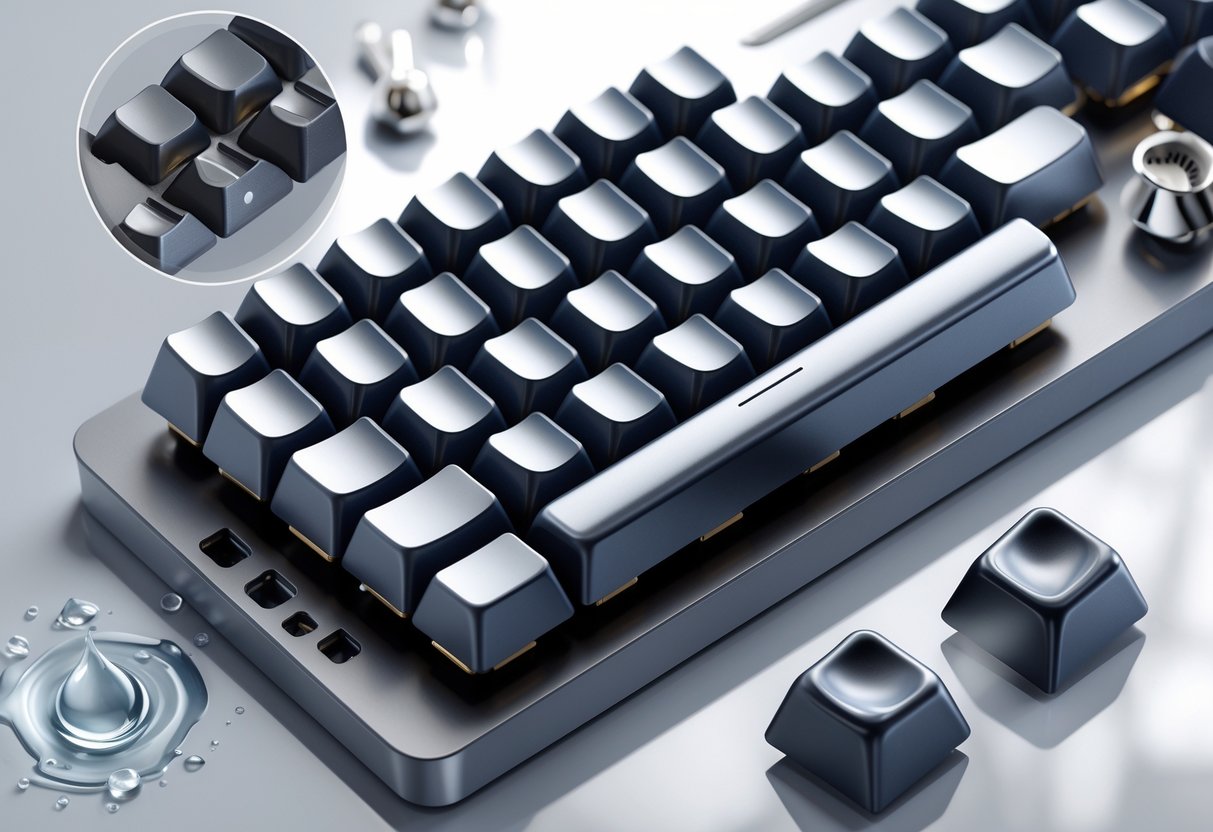
Custom keycaps can last for years if you take care of them and pick quality materials. Knowing how to clean and maintain them helps you get your money’s worth.
Cleaning and Upkeep
Regular cleaning keeps your keycaps looking sharp and working well. Most of the time, you just need some basic upkeep.
For daily cleaning, wipe the keycap surfaces with a damp cloth and mild soap. Stay away from harsh chemicals—they can mess up the legends.
For a deeper clean, pull the keycaps off with a keycap puller. That way, you won’t damage the switches and you can clean each cap thoroughly.
Different materials need different care:
- ABS keycaps: Gentle soap and water, skip anything abrasive
- PBT keycaps: Tougher, so you can use slightly stronger cleaners
- Metal keycaps: Use metal-safe cleaners to avoid corrosion
Preserve your legends. Double-shot moulded legends hold up best since they’re part of the plastic. Pad-printed legends need a gentler touch so they don’t fade.
Keep your workspace clean, too. Dust and crumbs will wear out your keycaps faster than typing ever will.
Long-Term Performance
High-quality custom keycaps can outlast the keyboard itself if you choose wisely and take care of them. Material choice is a huge factor.
PBT keycaps usually outlast ABS. They resist shine and keep their texture longer. ABS keycaps can get glossy and slick after lots of use.
Legend durability depends on production:
- Dye sublimation: Legends fade very slowly
- Double-shot: Legends basically never fade or chip
- Laser etching: Middle-of-the-road durability
- Pad printing: Most likely to wear off
If you type a lot, go for thicker keycaps from brands like GMK or JTK. Their premium ABS plastic beats the cheap stuff by a mile.
Typical lifespans:
- Quality PBT sets: 5-10 years
- Premium ABS sets: 3-7 years
- Budget keycaps: 1-3 years
Just replace individual caps as they wear out—spacebars and enter keys take the most punishment.
Cost Considerations and Accessibility
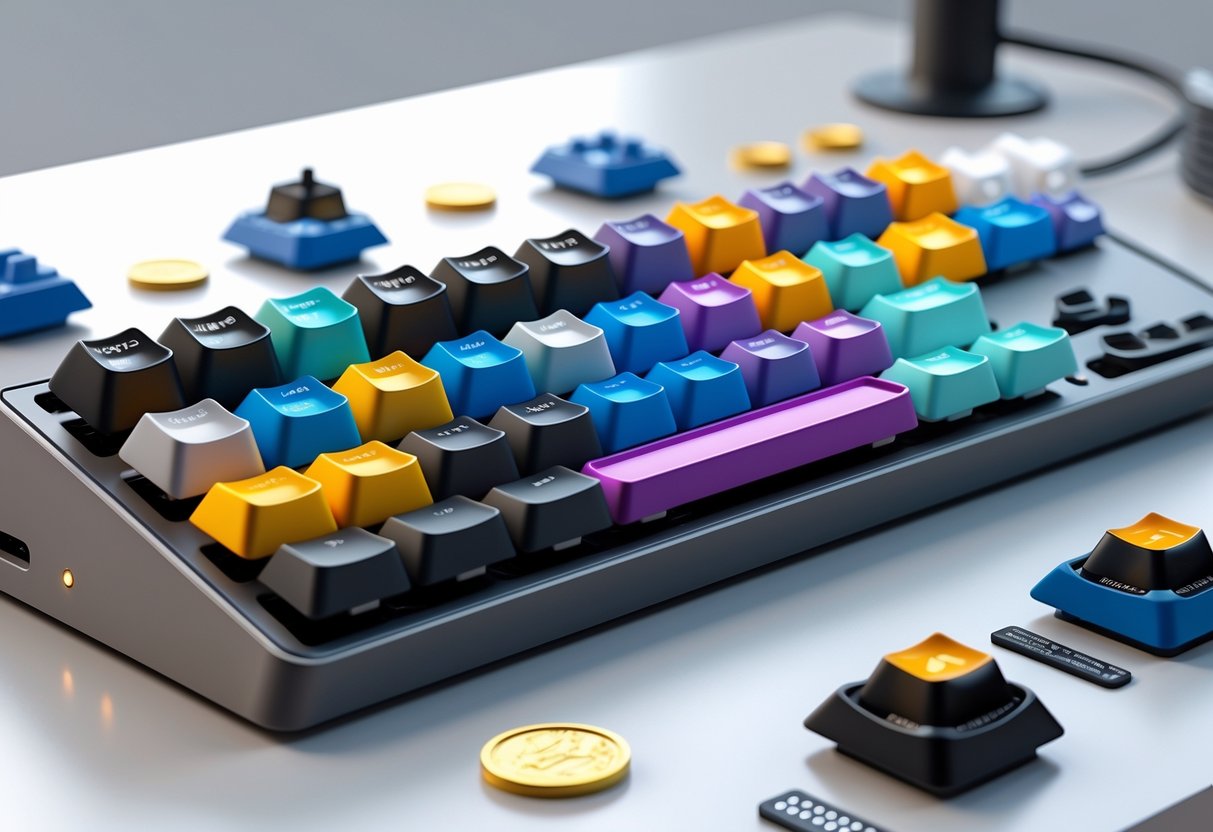
Custom keycaps can cost anywhere from under £20 for basic sets to hundreds for rare artisan pieces. There’s something out there for every budget, but quality and features jump a lot depending on what you spend.
Budget-Friendly Options
You can grab a decent custom keycap set for £15-40. These usually use ABS plastic with simple dye-sublimated legends.
Entry-level materials:
- ABS plastic: Smooth feel, but gets shiny over time
- Basic PBT: More durable, with a light texture
- Standard profiles: Cherry or OEM shapes
Most budget sets come from Asian manufacturers. They’re good value, though sometimes you get thin walls or colours that don’t quite match.
Typical prices:
- Full 104-key sets: £15-30
- Accent keys for gaming: £8-15
- Simple artisan caps: £5-12 each
Budget keycaps are great for trying out new styles. Honestly, it’s smart to start with a few accent keys before you swap your whole board.
Heads up: Super cheap keycaps under £10 usually have legends that fade in no time.
Premium and Luxury Keycaps
High-end custom keycap sets run from £60 to £200 or more. You get premium materials like double-shot PBT and custom profiles for the price.
Premium features:
- Double-shot legends: Characters moulded into the plastic
- Thick PBT: 1.5mm+ walls for extra durability
- Custom profiles: SA, XDA, or unique shapes
Artisan keycaps sit at the top—each piece can cost £30-150, especially for hand-crafted designs.
Material upgrades:
- Metal keycaps (aluminium/zinc): £80-200 per set
- Resin artisans: £25-60 each
- Limited editions: £100+ each
Premium sets usually come with better packaging and extra keys for different layouts. Quality control is tighter, too.
If you type all day, these are worth it. The feel and durability really do make a difference over time.
Frequently Asked Questions
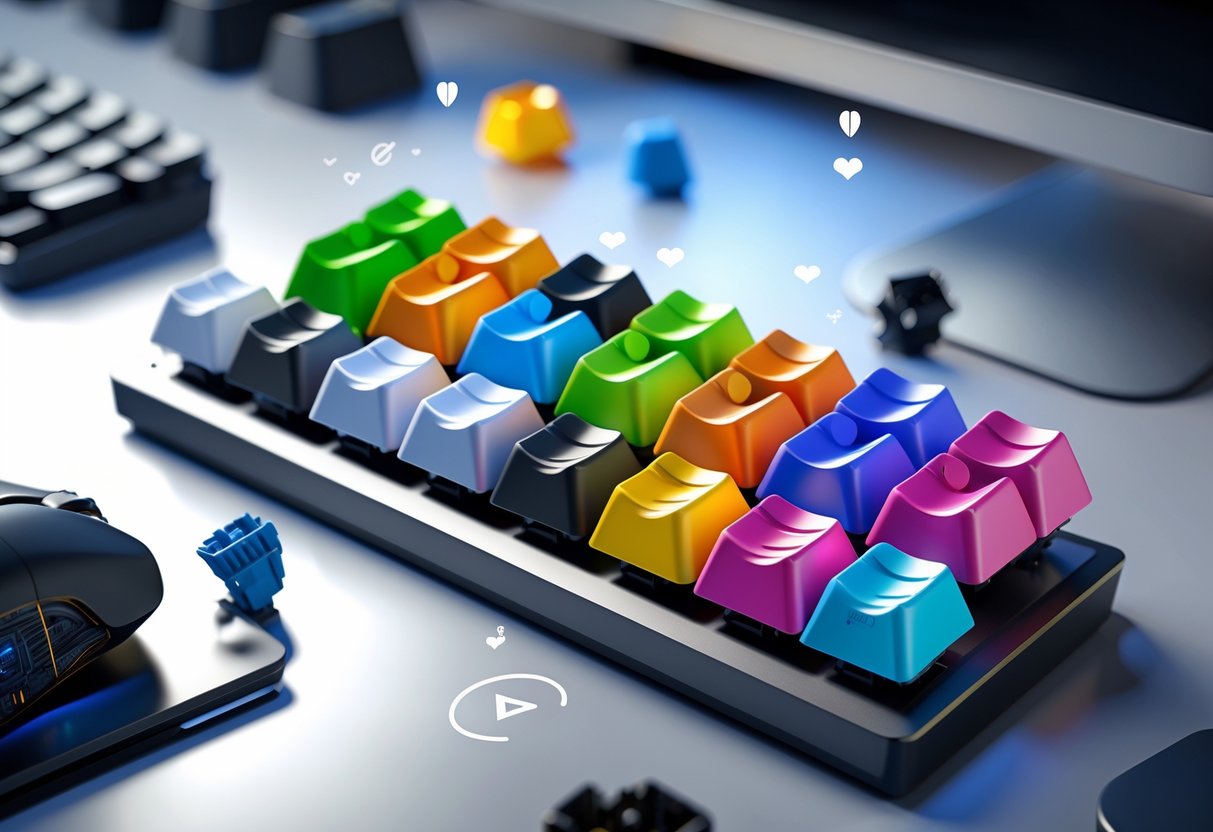
Custom keycaps can really change up your typing experience. Better materials and unique profiles make typing more comfortable, while bold designs give your keyboard some real personality.
If you pick the right materials, you’ll get extra durability and maybe even an edge in gaming. Just don’t forget to clean them now and then—maintenance keeps them looking sharp.
What advantages do custom keycaps offer for typing experience?
Custom keycaps can make typing feel a lot nicer. PBT keycaps, for example, have a textured surface that’s just more pleasant than the slippery ABS plastic you find on most stock keyboards.
Keycap profile matters, too. Sculpted profiles help your fingers find their way from key to key, which can really cut down on strain during long work sessions.
Changing up the height and angle of your keycaps can boost accuracy. Some profiles are designed to match your natural finger movements, making typing less of a chore.
How can personalised keycaps enhance the aesthetics of my keyboard?
With custom keycaps, you get to show off your style. Whether you like a minimalist look or something wild and colorful, there’s a set out there that’ll fit your vibe.
A lot of custom sets come in color combos you’d never see on a regular keyboard. Suddenly, your setup isn’t just functional—it actually says something about you.
Artisan keycaps take it up a notch. These handcrafted pieces are like little sculptures for your keyboard and always grab attention.
If you’re into games, movies, or certain hobbies, themed sets let you build a keyboard that’s uniquely yours. It’s a small thing, but it can make your workspace feel more personal.
In what ways do custom keycaps contribute to gaming performance?
Gaming keycaps usually come with special textures. For example, WASD keys might have bumps or a different feel, so you can find them without looking.
Some sets use bright colors or special legends for gaming keys. That way, your fingers know exactly where to go during those frantic moments.
Certain profiles put gaming keys at just the right angle for quick presses. If you care about shaving off even a few milliseconds, this can help.
Backlit-compatible keycaps let your RGB lighting shine through. That makes it easier to see your keys when you’re gaming in the dark.
What should I consider when choosing materials for my custom keycaps?
PBT plastic stands out for durability. It resists shine and keeps its texture, even if you’re typing all day, every day.
ABS plastic feels smoother, but it gets shiny over time. The upside? ABS keycaps often come in more colors and usually cost less.
Think about keycap thickness, too. Thicker keycaps give you a deeper, more satisfying sound and a premium feel.
Double-shot keycaps last longer because they use two layers of plastic for the legends. That means the markings won’t fade away, no matter how much you type.
How do custom keycap designs affect the durability of my keyboard?
High-quality keycaps help protect your keyboard’s switches from dust and debris. That can keep your mechanical switches working longer.
PBT keycaps in particular resist cracking and breaking, even if you’re not exactly gentle with your keyboard.
Well-made legends stick around. Double-shot or dye-sublimated legends won’t fade, so your keys stay readable.
A good keycap design spreads out the force when you type. That prevents extra wear on your switches, which is always a good thing.
Can you recommend ways to maintain custom keycaps to keep them looking great?
Clean your keycaps regularly with some mild soap and warm water. Take them off the switches first—trust me, it makes things way easier.
Let the keycaps soak for a bit, then grab a soft brush and gently scrub away any oils or dirt you spot.
Always use a keycap puller instead of your fingers when you remove the caps for cleaning. This little tool actually helps protect both your keycaps and the switches underneath.
If you have extra keycaps, store them in protective containers so they don’t get scratched or collect dust. Most custom keycap sets come with storage trays, which is pretty handy.
Skip the harsh chemicals or abrasive cleaners—they can mess up the keycap material or the legends. For stubborn stains, isopropyl alcohol usually does the trick and won’t cause damage.

